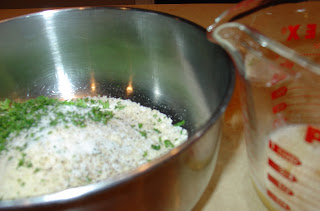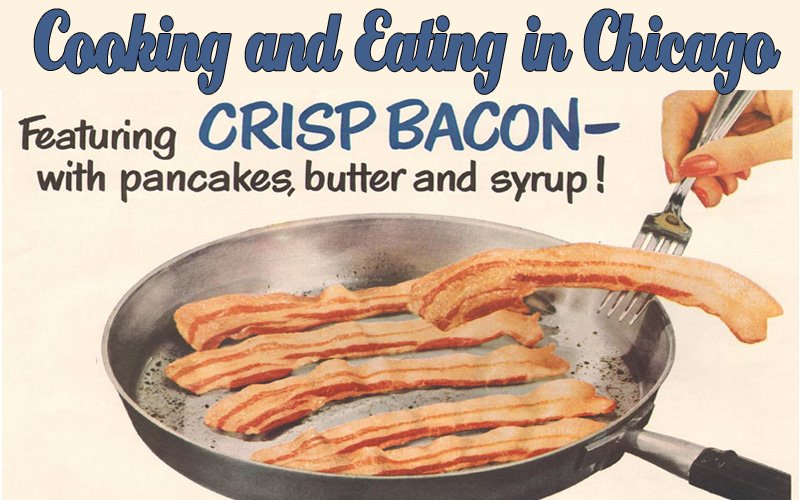
It's tempting, when beginning a piece about mac and cheese, to go on a long-winded rant about all those nasty powder-cheese concoctions that line the shelves, trying to lure you with their supposed ease of preparation, their overly salty cheesiness, and strangely skinny noodles.
I'll go ahead and resist that particular temptation, as I'm sure it's been done to death. As a transition, though, I will share a funny anecdote--the story of what happened the first time I ever tried to make Kraft Mac and Cheese. I was probably a sophomore in high school, and wasn't much of a cook at the time. My range was limited to after-school microwaving and toaster-ovening and sporadic Sunday-morning pancake-flipping.
But, I was hungry after school and the usual stuff wasn't going to cut it this day, so I decided to make myself a batch of the ol' blue box. I was no cook, but I could follow instructions, I figured. So I did exactly what the box said; I cooked the pasta in boiling water, then added the contents of the packet, plus a little milk and butter. I stirred and stirred, but I was mystified about why it never thickened up. It was like soup.
What the heck did I do wrong? I called a friend and asked her and we went through it step by step. "Ok, so then you drained the pasta, and added the cheese powder, right?" she said.
"Uh...drained the pasta?"
Whoops. I guess that's where it went bad.
Seriously, though, this tells you about my level of cooking ability at the time. I didn't know to drain the pasta, and the instructions didn't even mention this crucial step! I blame Kraft's recipe writers. C'mon, people! Lowest common denominator! Plastic garbage bags have messages telling me not to wear them over my face, and my wife's hairdryer has a tag on the cord with a message that reads "DO NOT USE WHILE SLEEPING", but you can't tell me to drain the frickin' pasta?!
(As an aside, the cheese powder packet that comes with the Kraft Mac and Cheese is really good sprinkled over hot popcorn. For a real dorm-room classic, combine the cheese packet from Kraft dinner with the foil seasoning packet that comes with ramen noodles, sprinkle over popcorn. Consume while drinking cheap beer. Enjoy.)
Anyway, I've come a long way since those days and now I make what I (and my family) believe is the very best macaroni and cheese......ever! This is the very same recipe I used in my triumphant appearance at the first annual sMACkdown, at which I tied Stephanie (Top Chef) Izard.
What follows is a step-by-step guide to making my mac and cheese. Included in this presentation is a bonus step-by-step to making Bechamel sauce; one of the classic French "mother sauces" and, as such, a wonderful leaping-off point for literally hundreds of different sauces. Seriously, Google it. Stuff like knowing how to make Bechamel with your eyes closed is why chefs don't need to use recipes.
 First, get a pot of water going for the pasta, and start making the Bechamel. I don't need to tell you to salt the pasta water, do I? It should taste like ocean water.
First, get a pot of water going for the pasta, and start making the Bechamel. I don't need to tell you to salt the pasta water, do I? It should taste like ocean water.Bechamel sauce is simply milk thickened with a roux. A roux is simply butter (or oil) and flour cooked together in equal parts to make a paste. Put the butter in a saucepan over low, add the flour and let it melt. Whisk the flour and butter together as it melts. You want to let the roux cook a bit just to cook out the raw flour flavor, but for mac and cheese, we're using a light-colored, or "blonde" roux, so you shouldn't let it take on any color.
 Once the roux is dry and kind of crumbly, and it's cooked for a few minutes, remove about half of it, so as to be better able to control how thick your sauce gets. You may end up using all of it, but it's better to be able to add it little by little than to have to keep adding more liquid to thin down your sauce.
Once the roux is dry and kind of crumbly, and it's cooked for a few minutes, remove about half of it, so as to be better able to control how thick your sauce gets. You may end up using all of it, but it's better to be able to add it little by little than to have to keep adding more liquid to thin down your sauce. Next, add the milk. Just a little at first. The roux begins thickening when it's boiled, so adding just a little milk will allow the mixture to boil almost immediately. It will quickly thicken up to the consistency of mashed potatoes (or wallpaper paste), which allows you to whisk out any lumps before adding the rest of the milk. Once it thickens up like you see in the pic to the left, go ahead and add the rest of the milk.
Next, add the milk. Just a little at first. The roux begins thickening when it's boiled, so adding just a little milk will allow the mixture to boil almost immediately. It will quickly thicken up to the consistency of mashed potatoes (or wallpaper paste), which allows you to whisk out any lumps before adding the rest of the milk. Once it thickens up like you see in the pic to the left, go ahead and add the rest of the milk. In the meantime, grate your cheese. I use cheddar (for flavor and color) and another cheese with better melting characteristics like Monterey Jack, fontina, or Swiss. My go-to is Gruyere, and then I add some Parmano cheese to bring up the sharpness.
In the meantime, grate your cheese. I use cheddar (for flavor and color) and another cheese with better melting characteristics like Monterey Jack, fontina, or Swiss. My go-to is Gruyere, and then I add some Parmano cheese to bring up the sharpness.
Also in the meantime (the milk takes a while to come up to a boil), make the breadcrumb topping. I use panko, salt and pepper, more Parmano cheese, chopped parsley, and melted butter. Just melt the butter in the microwave, combine everything else in a bowl, and then pour in the butter and stir it all around with a fork so the melted butter coats everything else.
By now the Bechamel will be more or less ready. You want it pretty loose, since adding all the cheese will thicken it up. It should have started to thicken, and come to a gentle boil. Let it boil for a couple minutes to allow the roux to thicken it, and add more roux as necessary to adjust the consistency. It's better to over-thicken it, since you can always thin it out with a bit more milk. But once you add the cheese, you can't add more roux, since bringing it to a boil would cause the cheese to separate.
 Once your Bechamel has thickened and you've allowed it to boil for a few minutes, remove it from the heat, let it cool a bit, and then add all the grated cheese to it, whisking to melt and incorporate the cheese. You'll also want to season it here. I use salt, pepper, and Tabasco sauce--not for the heat, but for the acidity it adds. Make sure you taste and re-season enough times so that you get that kind of pinch in the back of your cheek that the sharpness of the cheddar provides.
Once your Bechamel has thickened and you've allowed it to boil for a few minutes, remove it from the heat, let it cool a bit, and then add all the grated cheese to it, whisking to melt and incorporate the cheese. You'll also want to season it here. I use salt, pepper, and Tabasco sauce--not for the heat, but for the acidity it adds. Make sure you taste and re-season enough times so that you get that kind of pinch in the back of your cheek that the sharpness of the cheddar provides.The sauce should be creamy and you should see some stringy-ness from all the melting cheese when you pull your whisk out. If it's too thick, add some milk to thin it down. You want it kind of thin, since adding the pasta, allowing it to cool, and baking it will all thicken it.
 When the pasta's cooked, drain it well, add the sauce to the large pasta-cooking pot, and then combine the pasta and sauce, tossing it well to coat it in the sauce.
When the pasta's cooked, drain it well, add the sauce to the large pasta-cooking pot, and then combine the pasta and sauce, tossing it well to coat it in the sauce.CRUCIAL TIP: Try to make sure your pasta is hot when you toss it with the cheese sauce, since it'll absorb the sauce much better than it will if you let it cool down first. Also, once the pasta and the sauce are combined, let the mixture sit in the pot for a while before putting it in your baking dish. This lets the sauce thicken up and soak into the pasta, preventing the sauce from pooling up in the bottom of the baking dish.
 At this point, taste it and adjust your seasonings again. Even if your sauce was perfectly seasoned, you may need to add more salt, pepper, or Tabasco to compensate for the addition of the bland pasta. You can also add more milk at this point if the mixture is too thick.
At this point, taste it and adjust your seasonings again. Even if your sauce was perfectly seasoned, you may need to add more salt, pepper, or Tabasco to compensate for the addition of the bland pasta. You can also add more milk at this point if the mixture is too thick.If you're adding stuff like peas, bacon, or ham, this is the point at which to do it.

Turn the whole mess out into a baking dish, top it with your crumb topping, and put it into a 350° oven, and bake it until you can see the cheese sauce bubbling up. Then crank up your oven's broiler and get the topping nice and brown.
 That's it. The top should be all toasty, buttery, and burnt-cheese tasting from the grated cheese in the topping, the mac and cheese will be super-creamy and rich-tasting, and you'll get that great contrast of the creamy interior with the crunchy browned topping. It's awesome stuff.
That's it. The top should be all toasty, buttery, and burnt-cheese tasting from the grated cheese in the topping, the mac and cheese will be super-creamy and rich-tasting, and you'll get that great contrast of the creamy interior with the crunchy browned topping. It's awesome stuff.Plus, once you've got the roux and Bechamel technique down, you can use it to make tons of other sauces. Country gravy and biscuits, chicken fried steak with sage cream gravy, and sauce Nantua (a cream-based Bechamel flavored with crawfish and other shellfish) are all examples of fairly well-known Bechamel-based sauces.
So that's it. My (nearly) award-winning mac and cheese recipe, complete with step-by-step photos and commentary. You now officially have no excuse for ever again buying any blue box, lecithin-laden, Velveeta Whiz-based product.












3 comments:
Shudders. I forgot there was such a thing as packet mac mix. Never tried it. Smelt it though, and that was enough.
Lump free bechamel - heat the milk. It's a revolution. If the milk goes in cold the flour proteins shrink instantly going from hot to cold - hence the lumps. If you add the milk hot to the hot roux it keeps the temperature even - and the sauce lump free. It's a simple thing that makes life so easy.
Is there any chance you'd share the various amounts associated with this recipe?
Hi Anonymous.
I could try, but I don't measure when I cook. If you read this blog, you'll find that I'm not a fan of recipes. I believe they're a crutch that prevent people from learning how to really cook.
However, if you want to email me, I'll throw something together for you.
Post a Comment